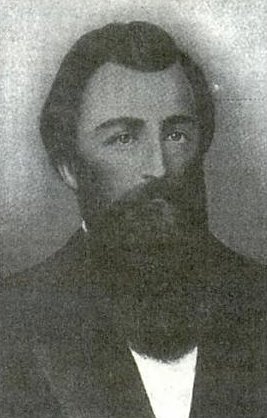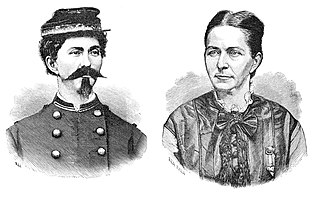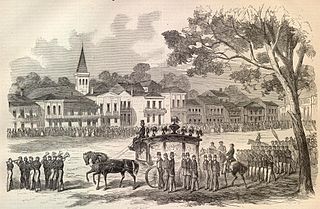
The Confederate States of America (CSA), commonly referred to as the Confederate States (C.S.), the Confederacy, or the South, was an unrecognized breakaway republic in the Southern United States that existed from February 8, 1861, to May 9, 1865. The Confederacy comprised eleven U.S. states that declared secession and warred against the United States during the American Civil War. The states were South Carolina, Mississippi, Florida, Alabama, Georgia, Louisiana, Texas, Virginia, Arkansas, Tennessee, and North Carolina.

The United Daughters of the Confederacy (UDC) is an American neo-Confederate hereditary association for female descendants of Confederate Civil War soldiers engaging in the commemoration of these ancestors, the funding of monuments to them, and the promotion of the pseudohistorical Lost Cause ideology and corresponding white supremacy.

Benjamin Franklin Butler was an American major general of the Union Army, politician, lawyer, and businessman from Massachusetts. Born in New Hampshire and raised in Lowell, Massachusetts, Butler was a political major general of the Union Army during the American Civil War and had a leadership role in the impeachment of U.S. President Andrew Johnson. He was a colorful and often controversial figure on the national stage and on the Massachusetts political scene, serving five terms in the U.S. House of Representatives and running several campaigns for governor before his election to that office in 1882.

Lieutenant-General Leonidas Polk was a bishop of the Episcopal Diocese of Louisiana and founder of the Protestant Episcopal Church in the Confederate States of America, which separated from the Episcopal Church of the United States of America. He was a planter in Maury County, Tennessee, and a second cousin of President James K. Polk. He resigned his ecclesiastical position to become a major-general in the Confederate States Army, when he was called "Sewanee's Fighting Bishop". His official portrait at the University of the South depicts him as a bishop with his army uniform hanging nearby. He is often erroneously referred to as "Leonidas K. Polk," but he had no middle name and never signed any documents as such.

Philip Phillips was an American lawyer and politician from Cheraw, South Carolina, Mobile, Alabama, and Washington, D.C. He was a member of the Democratic Party who served as the U.S. representative from Alabama. Subsequently, he was a prominent lawyer in Washington, D.C., much involved in the political events surrounding the American Civil War.

William Bruce Mumford was a North Carolina native and resident of New Orleans, who tore down the U.S. flag raised over Confederate New Orleans after the city was captured by Union troops during the American Civil War. In response, Union Army Maj. Gen. Benjamin Butler, the commander of the Union ground forces, had Mumford court-martialed and executed for treason.

Loreta Janeta Velázquez was an American woman who wrote that she had masqueraded as a male Confederate soldier during the American Civil War. The book she wrote about her experiences says that after her soldier husband's accidental death, she enlisted in the Confederate States Army in 1861. She then fought at Bull Run, Ball's Bluff, and Fort Donelson, but was discharged when her sex was discovered while in New Orleans. Undeterred, she reenlisted and fought at Shiloh, until unmasked once more. She then became a Confederate spy, working in both male and female guises, and as a double agent also reporting to the U.S. Secret Service. She remarried three more times, being widowed in each instance. According to William C. Davis, she died in January 1923 under the name Loretta J. Beard after many years away from the public eye in a public psychiatric facility, St. Elizabeths Hospital. Most of her claims are not supportable with actual documents, and many are contradictable by actual documentation.

The capture of New Orleans during the American Civil War was a turning point in the war that precipitated the capture of the Mississippi River. Having fought past Forts Jackson and St. Philip, the Union was unopposed in its capture of the city itself.

Thomas Jenkins Semmes was an American politician who served as a Confederate States Senator from Louisiana from 1862 to 1865. He was the 9th president of the American Bar Association 1886–1887.

The battle of Forts Jackson and St. Philip was the decisive battle for possession of New Orleans in the American Civil War. The two Confederate forts on the Mississippi River south of the city were attacked by a Union Navy fleet. As long as the forts could keep the Federal forces from moving on the city, it was safe, but if they fell or were bypassed, there were no fall-back positions to impede the Union advance.

New Orleans, Louisiana, was the largest city in the South, providing military supplies and thousands of troops for the Confederate States Army. Its location near the mouth of the Mississippi made it a prime target for the Union, both for controlling the huge waterway and crippling the Confederacy's vital cotton exports.

André Cailloux was an African American army captain, one of the first black officers of any North American military unit. He was also one of the first black soldiers to die in combat during the American Civil War. He was killed during the unsuccessful first attack on the Confederate fortifications during the Siege of Port Hudson. Accounts of his heroism were widely reported in the press, and became a rallying cry for the recruitment of African Americans into the Union Army.

Louisiana was a dominant population center in the southwest of the Confederate States of America, controlling the wealthy trade center of New Orleans, and contributing the French Creole and Cajun populations to the demographic composition of a predominantly Anglo-American country. In the antebellum period, Louisiana was a slave state, where enslaved African Americans had comprised the majority of the population during the eighteenth-century French and Spanish dominations. By the time the United States acquired the territory (1803) and Louisiana became a state (1812), the institution of slavery was entrenched. By 1860, 47% of the state's population were enslaved, though the state also had one of the largest free black populations in the United States. Much of the white population, particularly in the cities, supported slavery, while pockets of support for the U.S. and its government existed in the more rural areas.

African Americans, including former slaves, served in the American Civil War. The 186,097 black men who joined the Union Army included 7,122 officers and 178,975 enlisted soldiers. Approximately 20,000 black sailors served in the Union Navy and formed a large percentage of many ships' crews. Later in the war, many regiments were recruited and organized as the United States Colored Troops, which reinforced the Northern forces substantially during the conflict's last two years. Both Northern Free Negro and Southern runaway slaves joined the fight. Throughout the course of the war, black soldiers served in forty major battles and hundreds of more minor skirmishes; sixteen African Americans received the Medal of Honor.

The 1st Louisiana Native Guard was a Confederate Louisianan militia that consisted of Creoles of color. Formed in 1861 in New Orleans, Louisiana, it was disbanded on April 25, 1862. Some of the unit's members joined the Union Army's 1st Louisiana Native Guard, which later became the 73rd Regiment Infantry of the United States Colored Troops.
During the American Civil War, sexual behavior, gender roles, and attitudes were affected by the conflict, especially by the absence of menfolk at home and the emergence of new roles for women such as nursing. The advent of photography and easier media distribution, for example, allowed for greater access to sexual material for the common soldier.

Kate Mason Rowland was an American author, historian, genealogist, biographer, editor and historic preservationist. Rowland is best known for her biography of her great-great-granduncle, George Mason, a Founding Father of the United States. Rowland was also a charter member of the United Daughters of the Confederacy. She later went by the name of "Kate Mason."

Arthur Forrester Devereux was a captain in the Massachusetts Volunteer Militia prior to the Civil War and a colonel in the Union Army during the Civil War. He is notable for his expertise and proficiency in the instruction of military drill. During the Battle of Gettysburg, the 19th Massachusetts Infantry, under his command, played an important role in filling a breach in the Union lines during Pickett's Charge. After his active service had concluded, Devereux was awarded the honorary rank of brevet brigadier general, United States Volunteers, by appointment of President Andrew Johnson on February 21, 1866, to rank from March 13, 1865, and confirmation by the U.S. Senate on April 10, 1866.

Slavery played the central role during the American Civil War. The primary catalyst for secession was slavery, especially Southern political leaders' resistance to attempts by Northern antislavery political forces to block the expansion of slavery into the western territories. Slave life went through great changes, as the South saw Union Armies take control of broad areas of land. During and before the war, enslaved people played an active role in their own emancipation, and thousands of enslaved people escaped from bondage during the war.

The Tennessee Confederate Women's Monument, also known as the Tennessee Monument to the Women of the Confederacy or the Monument to Southern Women in War Times, is a bronze statue on the grounds of the Tennessee State Capitol in Nashville, Tennessee, USA.



















